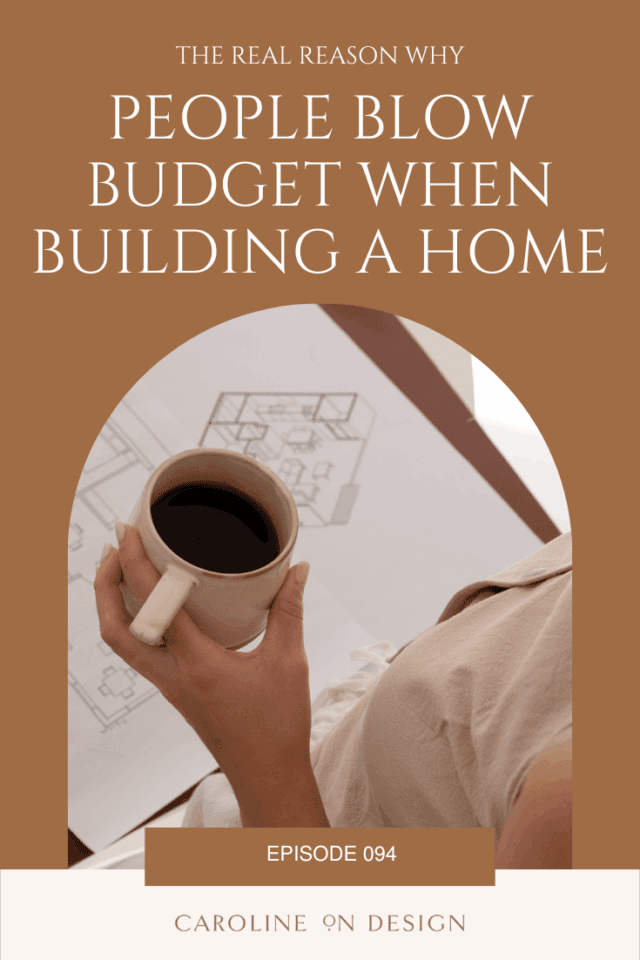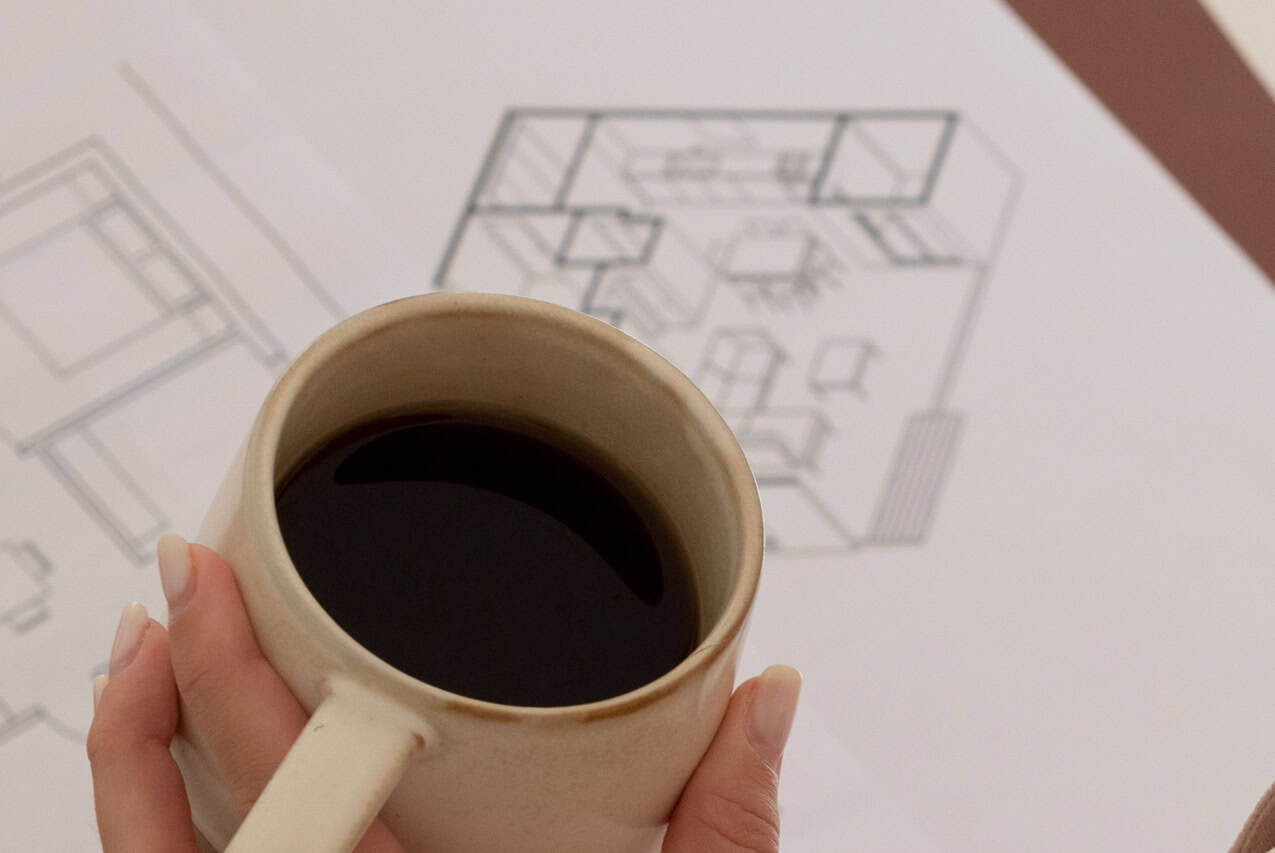Welcome to the Before You Build podcast. I’m your host Carrie Barker, aka Caroline On Design, and today in episode 94, I’m breaking down the real reason people blow their home build budget, plus exactly what you can do to avoid this happening to you.
You’ve probably heard this advice before: “Whatever your builder quotes you, expect to pay 30 to 35 percent more.”
This advice is so terrible. I can’t stand it because here’s the truth: going over budget is NOT inevitable.
When you plan your home the right way (BEFORE you ever break ground), you can make decisions that protect both your vision AND your wallet.
Listen to this episode or read the full transcript below.
Links Mentioned in this Episode:
Ready to build without blowing your budget? Watch my FREE training, “3 Simple Steps to Build Your Dream Home Without Blowing Your Budget”.
Below is the full podcast episode transcript:
Welcome to the Before You Build podcast. I’m your host Carrie Barker, aka Caroline On Design, and today in episode 94, I’m breaking down the real reason people blow their home build budget, plus exactly what you can do to avoid this happening to you.
You’ve probably heard this advice before: “Whatever your builder quotes you, expect to pay 30 to 35 percent more.”
This advice is so terrible. I can’t stand it because here’s the truth: going over budget is NOT inevitable.
When you plan your home the right way (BEFORE you ever break ground), you can make decisions that protect both your vision AND your wallet.
Why the “30% Over Budget” Myth Exists (And Why It’s Wrong)
First, let’s talk about where this whole “30 to 35 percent over budget” thing even comes from.
It’s not that builders are out to get you or that construction costs are wildly unpredictable.
(although they are a little unpredictable with the tariff situation).
The real problem is much simpler than that.
Most people go over budget because they weren’t clear about what they wanted from the beginning.
They got a quote from their builder based on a general idea—or maybe just a basic sketch—of their home. But as the build progresses and they start seeing their house take shape, they suddenly realize what they REALLY want.
And guess what? Their dream home comes with a dozen upgrades they didn’t plan or budget for.
Let me give you a real example of how this plays out.
How Vague Planning Leads to Expensive Home Build Budget Overages
Let’s say your builder quotes you for semi-custom cabinets with full overlay doors.
You say yes because, honestly, it sounds fine. You don’t know much about cabinets yet, and you trust your builder to handle the details.
But then, as you’re finalizing your kitchen design a few months later, you start scrolling through Pinterest. You see those gorgeous inset cabinet doors. You fall in love with the look. You realize that’s what you’ve wanted all along.
So you ask your builder about switching to fully custom cabinets with inset doors.
Here’s the problem: that’s not a small upgrade. That’s a major jump in price. And since it wasn’t discussed upfront, you’re now dealing with a significant budget overage in the middle of your build.
Now multiply that scenario by five or ten other features. Maybe it’s lighting fixtures, hardwood flooring, designer tile, upgraded appliances, built-in storage, or high-end plumbing fixtures.
Suddenly, you’re 30 percent over budget and wondering how this happened.
But it doesn’t have to be this way.

The Secret to Staying On Budget When Building a Custom Home
The key to staying on (or very close to) budget isn’t lowering your expectations. It’s getting crystal clear on your priorities and choices BEFORE construction starts.
This means knowing:
- Where you want to splurge and where you’re okay saving
- How to communicate clearly with your builder and architect
- What your allowances actually cover
- How to make intentional decisions with long-term value in mind
When you do this planning work upfront, you avoid those expensive mid-build surprises.
You know exactly what you’re getting.
Your builder knows exactly what you want.
And there’s no confusion, no miscommunication, and no budget-blowing panic.
Ready to build without blowing your budget? Watch my FREE training, “3 Simple Steps to Build Your Dream Home Without Blowing Your Budget”.
Plan Your Home Build Ahead Like a Pro
Clarify Your Vision Before You Start Building
First, clarify your vision before you ever meet with a builder or break ground.
Don’t wait until construction starts to figure out what you want. Use Pinterest boards, mood boards, and planning tools to define your style, your must-haves, and your non-negotiables.
Get specific. I’m talking about knowing whether you want hardwood throughout or carpet upstairs. Whether you want a farmhouse sink or an undermount sink. Whether you need built-ins in the mudroom or open shelving in the kitchen.
The more clarity you have upfront, the more accurate your builder’s quote will be … and the less likely you are to face expensive surprises later.
Ask Specific Questions About Builder Allowances
Next, you need to ask specific questions about allowances.
Here’s what most people don’t realize: when your builder gives you an allowance (let’s say a ten thousand dollar lighting allowance), that number doesn’t tell you much.
You need to dig deeper. Ask questions like:
- What style or brands does this allowance cover?
- Does it include installation costs?
- What happens if I go over this amount?
- Can you show me examples of fixtures that fit within this budget?
These conversations help you understand whether the allowance matches your vision or if you need to adjust your budget or expectations.
Share Your True Expectations Early in the Process
And finally, share your true expectations early.
If you know you want hardwood floors throughout the entire house (not just the main level) tell your builder upfront.
If you’re dreaming of designer tile in the primary bathroom or a custom range hood in the kitchen, mention it during the quoting phase, not after framing is complete.
The more transparent you are about your vision from the beginning, the more accurate your budget will be … and the less likely you’ll be dealing with change orders and overages later.
Why a Realistic Buffer Doesn’t Mean 30 Percent
Now, I’m not saying that nothing will come up during your build. Things happen. You might discover a structural issue that needs addressing. You might decide to upgrade one or two things along the way.
That’s why I always recommend building in a realistic buffer.
But here’s the key: with solid planning, a 5 to 10 percent buffer is often enough to handle surprises. You don’t need 30 percent.
That massive overage people talk about? That’s what happens when you don’t plan ahead. When you’re making decisions on the fly, when you’re reactive instead of proactive.
But when you follow a clear process? When you know what you want and communicate it effectively? You can build a home you absolutely love without blowing your budget.
Real Client Success Stories: Staying On (or Under!) Budget
Don’t just take my word for it. Let me share a couple of real examples from my BEFORE YOU BUILD℠ clients.
Mare went into her build with a clear plan. She knew exactly what she wanted, she communicated it to her builder upfront, and she made strategic decisions about where to splurge and save.
The result? She came in sixty-five hundred dollars under budget.
Monica had a similar experience. She created a strategic spending plan from day one, avoided the guessing game, and finished her build twelve thousand dollars under budget.
The difference between these clients and people who go 30 percent over budget isn’t luck. It’s not a bigger budget. It’s preparation.
They did the planning work BEFORE they started building. And that made all the difference.
Your Biggest Home Build Investment Deserves a Plan
Listen, building a custom home is probably the biggest investment you’ll ever make. It’s expensive, it’s exciting, and it’s overwhelming.
But it doesn’t have to be stressful.
When you approach your home build with a clear plan (when you know what you want, you understand your budget, and you communicate effectively with your builder), you can create a home you absolutely love without the financial panic.
The most expensive home-building mistakes are the ones made in the dark. When you’re rushed, unclear, or reactive.
But when you plan ahead with intention? You can make smart, confident decisions that honor both your vision and your budget.
Next Steps
If you’re feeling overwhelmed and wondering where to even start with all this planning, I’ve created something just for you.
It’s my free training called, “3 Simple Steps to Build Your Dream Home Without Blowing Your Budget.”
In this training, I walk you through:
- The three biggest costly mistakes that derail most builds and how to avoid them
- My proven BEFORE YOU BUILD BLUEPRINT℠ framework (these are the actual steps that my clients follow to build with confidence)
- Real examples of families who stayed on budget or even came in under budget
- Your next actionable moves to build without regrets and actually enjoy the experience
This is the same framework that’s helped more than 500 families plan and build custom homes they absolutely love … without blowing their budget and without regrets.
The insights you’ll gain will help you plan smarter from day one, even if you’re not breaking ground for another year. 🙌
